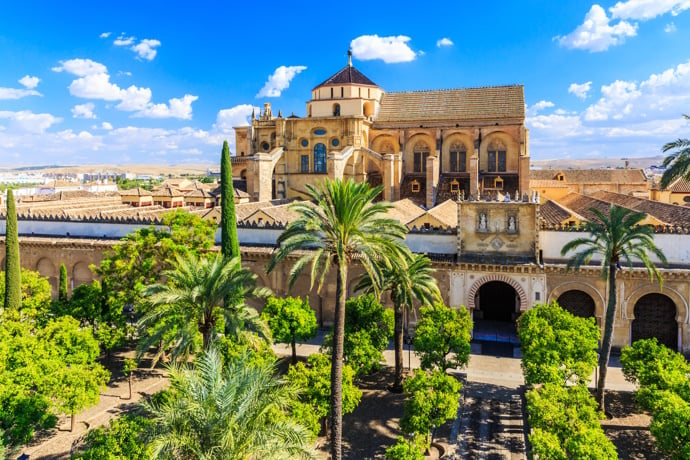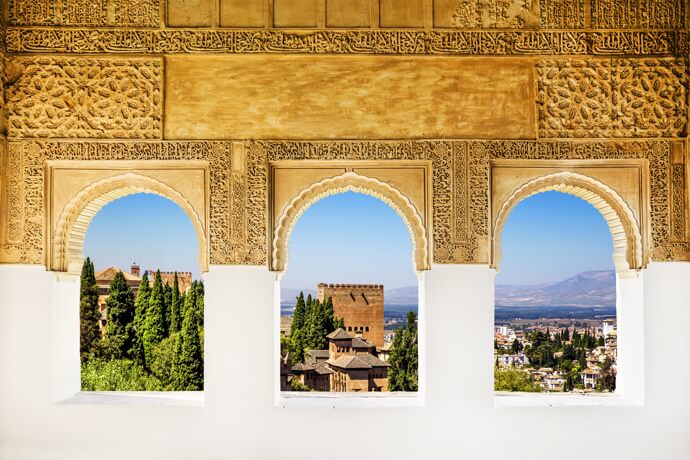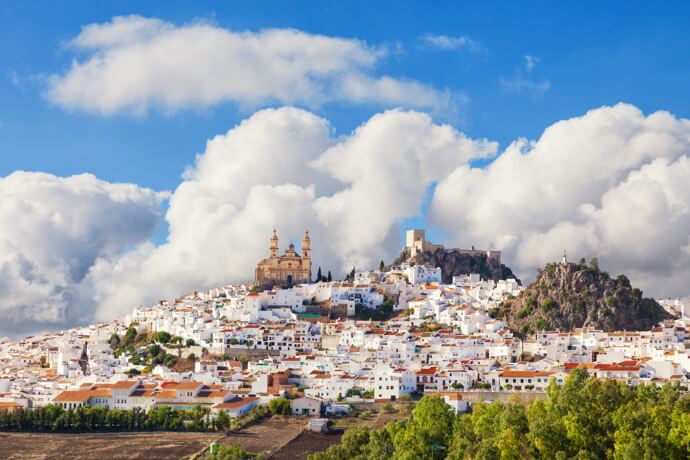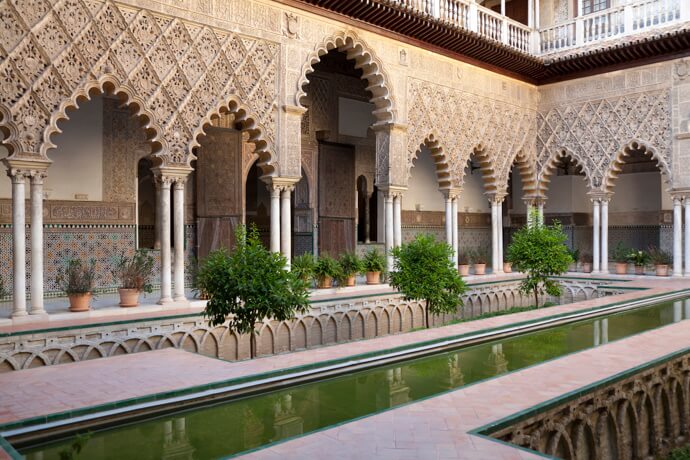Throughout its history, part of the territory known today as Spain constituted a Moorish kingdom called Al-Andalus. This powerful kingdom stayed in the Iberian Peninsula for almost 800 years, until the Spanish Catholic kings conquered the last city, Granada, in the region now called Andalusia.
Even with the end of the Al-Andalus kingdom, in the 15th century, Spain managed to preserve the remains of this important historical period. More than traces of a distant past, the Moorish presence is alive in Andalusia, in its culture and also before our eyes, in mosques, palaces, castles, museums, and even in the labyrinthine streets of small white villages. In some main cities, it is possible to appreciate monuments that encompass a mixture of Moorish, Catholic, Baroque, and Gothic features, in a style called Mudéjar.
Come with us on a cultural journey in Andalusia and discover the Legacy of Moorish Spain!
Seville

Andalusia’s capital holds immeasurable treasures of Moorish architecture from the time when it was a great metropolis in the Al-Andalus territory, with beautiful palaces and a lively artistic life. The Royal Alcázar of Seville still echoes those remarkable times. This stunning set of palaces began to be designed by the Moors, in 713, and became the official center of the reign. When it passed into the hands of the Christians, they started adding sections or reforming the previous ones. So, besides the typically Islamic and Mudéjar architecture with its beautiful gardens, the palace also has Renaissance and Baroque decorations that look like a demonstration of the historical evolution of the Iberian Peninsula. The Royal Alcázar of Seville is considered the oldest royal palace still in use in Europe, as it is the residence of the Spanish royal family on their visits to the city.
The impressive Cathedral of Seville also holds architectural remains from its Moorish origins. Built in the 12th century as the city’s mosque, it was converted into a cathedral a century later by the Christians, conserving the great minaret known today as Giralda. Both the Real Alcázar and the Cathedral of Seville were declared UNESCO World Heritage.
Several other churches rest on Moorish ruins and unveil small details of this past, such as the Divino Salvador Church. Also, on the Guadalquivir River shore, the Torre del Oro was built by the Moors as a defensive tower. Locals say its name is due to the golden reflections caused by the tiles that lined the tower originally.
Córdoba

Córdoba is like an open-air museum where you can find some of the most fascinating remains of the Moorish legacy in Spain. The Mosque-Cathedral of Córdoba is a key temple and the most visited monument in the city. With more than 13 centuries of history, this building served as a place of worship for Visigoths, Moorish, and Christians. Being amplified over the centuries, it is now one of the biggest mosques in the world, and its interior is jaw-dropping, mainly due to the hundreds of arches and columns in its prayer room. Although it is still called a "mosque", it has been functioning as a Catholic church for centuries, deviating from its original purpose.
The Great Mosque of Córdoba was declared a World Heritage Site in 1984, and 10 years later the nomination was extended to the Córdoba historic center, the Alcazar de los Reyes Cristianos, the Roman Bridge, and the Calahorra Tower. The Alcázar de los Reyes Cristianos was built on a former Moorish Alcázar and keeps two of its original towers. It was always an important building and it was here that the Catholic Kings met with Christopher Colombus to arrange his travel to the American continent - it is therefore a fundamental monument in the history of Córdoba. If you wish to learn more about the Spanish Moorish legacy, visit the Al-Andalus Museum, located in the Calahorra Tower, an original Moorish fortification.
About 8 kilometers away there is an archeological place with the most importance: Medina Azahara. It was a city built on the outskirts of Córdoba, to aggregate administrative and residential purposes of the caliphate, and only 10% of it has been excavated yet.
Granada

Granada is one of the most famous cities in Andalusia thanks to the Moorish presence that over the centuries has changed its structure and conditioned its soul. This city holds the rank of being the last Al-Andalus city conquered by the Spanish Catholic army and therefore is a precious stronghold of magnificent examples from the Al-Andalus era.
The Alhambra is a world-known postcard from Granada and Andalusia, and a UNESCO World Heritage Site. It represents the largest example of the Moorish legacy in Spain and its name derives from the Arab, meaning “red castle”. It is a large complex comprising a fortress with gardens and palaces, with a strategic defense purpose. Although other structures have been included over the centuries, Alhambra is still one of the monuments that maintained the authentic Andalusian Moorish style. Strolling through its facilities is an invitation to return to the pompous past of Al-Andalus, noticing the typical Moorish architecture intermixed with carefully designed gardens along with fountains and water mirrors. In fact, the water resources of Alhambra are a spectacle apart, since its builders were able to make a connecting channel, bringing water from the mountains and supplying the entire complex - it is considered an engineering marvel to this day. To the east of the Alhambra are the magnificent gardens of the Generalife, the former rural residence of the emirs in the 13th and 14th centuries.
But Moorish Granada is much more than Alhambra. The Madraza Palace was the first University of Granada, created in 1400, and maintains decorations that will leave you speechless.
In the Albayzín quarter, you will experience a lively atmosphere with a Moorish feel in the architecture, the labyrinthic streets, the “teterias” or tea houses with shisha, and the gastronomy from Northern Africa and the Middle East. In the city center, the Alcaiceria market reminds us of the Grand Bazar of Istambul; and there are also Arab Baths all over the city maintaining a thousand-year-old tradition of the hammam.
Pueblos Blancos

A world of Moorish charm awaits visitors traveling to the picturesque Pueblos Blancos of Andalusia. These small, quiet hilltop towns whose name literally means white villages, are distinguished by their simple whitewashed houses popping in the landscape, influenced by the Moorish legacy. There are over 20 villages spread across the amazing mountains in Andalusia, each one more picturesque than the other. Compared to the big cosmopolitan cities of Seville, Córdoba, and Granada, these little villages bring a sense of tranquility in nature.
Arcos de la Frontera is one of the most visited of the Pueblos Blancos. Once an 11th-century fortress, it is strategically located on top of a cliff on the banks of the Guadalete River, and its narrow streets and winding alleys adorned with whitewashed arches enable its Moorish legacy. Grazalema is also a beautiful high mountain village nestled in a valley. Surrounded by stunning scenery, is ideal for nature walks and is one of the best examples of an Andalusian Pueblo Blanco, with its labyrinth of pedestrian streets leading to hidden spots and fantastic views of the mountains. Setenil de las Bodegas is the most peculiar, with houses carved in caves and excavated in the rock, giving the feeling of being under rocky cliffs. The ruins of its 12th-century Moorish castle offer beautiful views of the village. The Aznalmara Castle, built in the 13th century, crowns the village of Benaocaz and in its historic center you will find the Barrio Nazarí, with its typical Moorish atmosphere, that dates back to the 8th century.
Some of the Pueblos Blancos, like Vejer de la Frontera or Salobreña, are located near the Mediterranean coast, and visitors may enjoy its charming Moorish essence with sea views and nearby beaches. On the other hand, in the Sierra Nevada Mountain, you will find Pueblos Blancos balanced in ravines and valleys, with backdrops of forests and a fascinating Andalusian legacy, like Pampaneira or Bubión.
Ronda, Jerez de La Frontera, Zahara de la Sierra, Antequera, and many more inherited the characteristic white houses adorned with flowers and little details as arches and tiles, the labyrinthic alleys, and the courtyards that often lead to breathtaking views. Here, in this part of Spain, the Moorish legacy is clearly alive!
The legacy of Moorish Spain: come and see it!

The several traces of Moorish culture present in the main cities of Andalusia and in some little villages of the region show the importance and the beauty of the Al-Andalus reign to the Iberian civilization. Now that you know how to identify it, come to Spain to enjoy it! You will be amazed!



